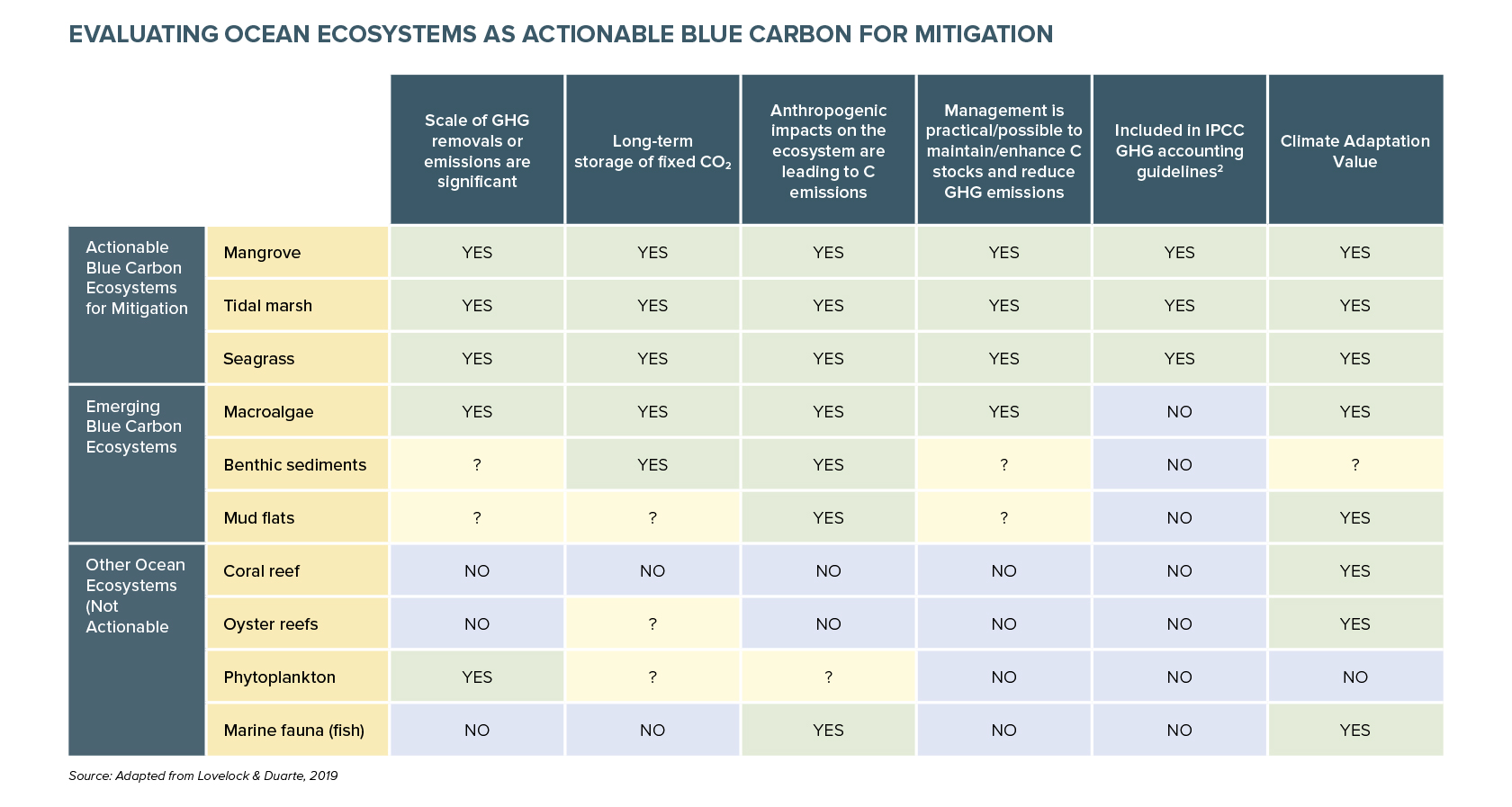With the world paying greater attention to the ocean’s health and climate change impacts, experts are touting an emerging suite of strategies that provide climate and resilience benefits: nature-based solutions, green infrastructure, and blue carbon. While there is some overlap between these and related terms, the differences—as well as the structures and systems they encompass—can be significant. Nature-based solutions are likely to become increasingly important for their potential as climate mitigation and adaptation infrastructure and their role in helping countries meet their nationally determined contributions (NDCs).
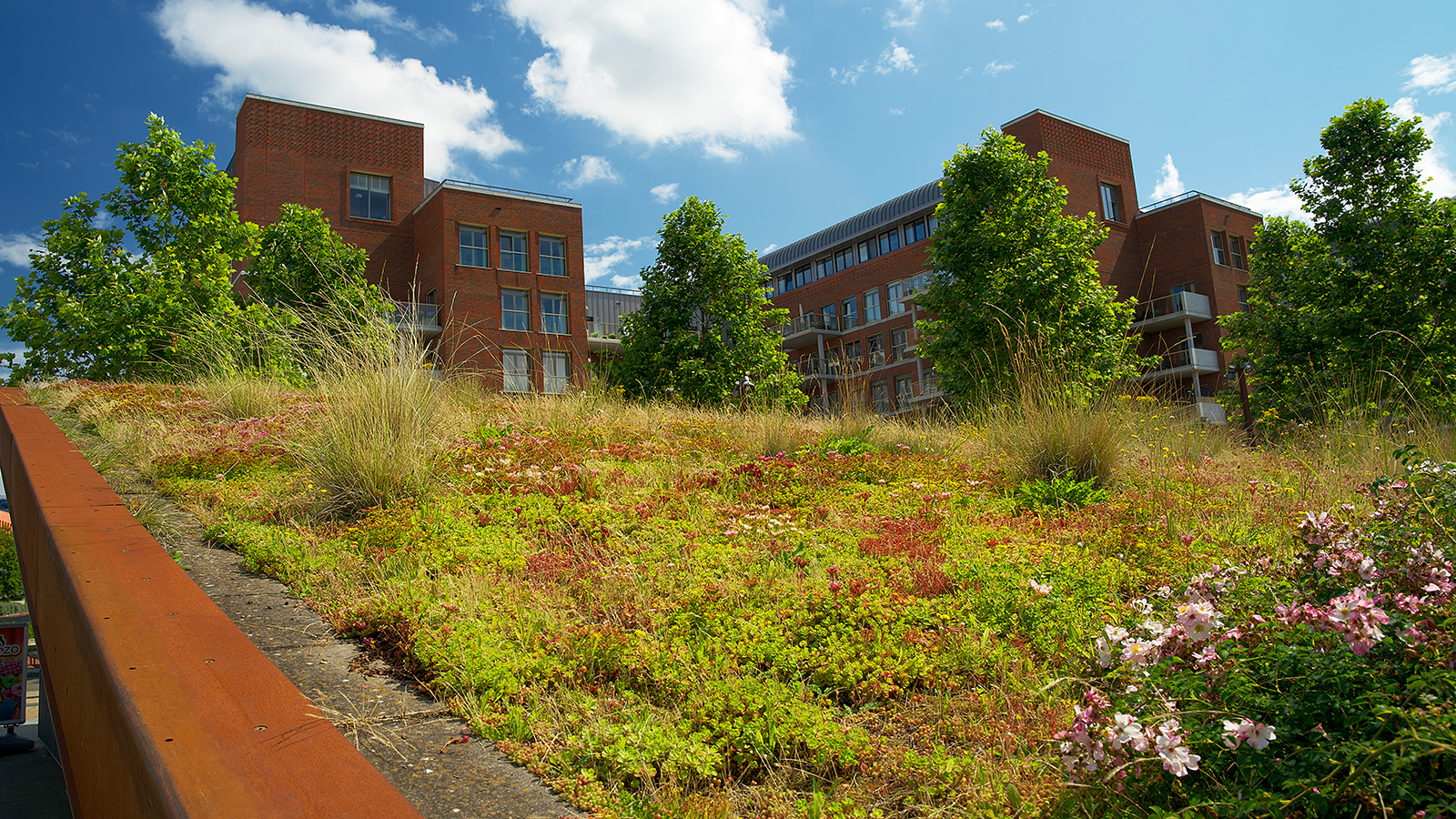
Green roof in The Netherlands. Photo: iStock/Rene Notenboomer
Read more to learn what nature-based solutions are, how they can improve ocean health and support marine ecosystems and biodiversity, and why they represent a new era of innovative societal and environmental solutions with an array of co-benefits.
What are nature-based solutions? Are they different from green infrastructure?
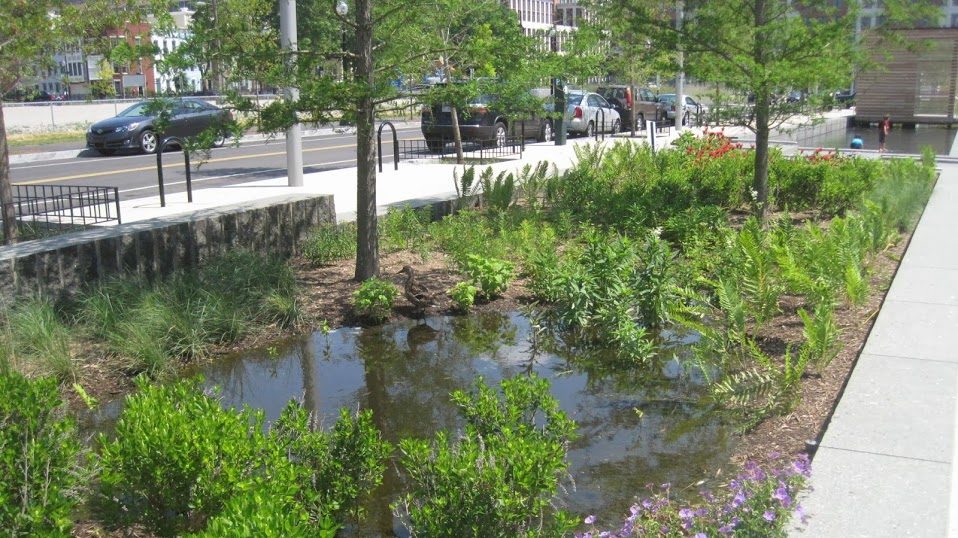
Rain gardens catch rain water that would otherwise run off into storm drains. Photo: Alisha Goldstein / EPA
A handful of terms are used to describe the utilization of natural features, systems, and landscapes to solve many of today’s environmental challenges, including nature-based solutions and green infrastructure. While these ideas and terms are gaining popularity and traction, confusion over the specific structures and systems the terms refer to may limit understanding of their potential impact. Some of the most commonly used terms are nature-based solutions, nature-based infrastructure, natural infrastructure, green infrastructure, blue infrastructure, and blue-green infrastructure.The definitions of these terms vary:
- Nature-based infrastructure or nature-based solutions (NbS) do not have a universal definition, but organizations such as the International Union for Conservation of Nature, World Resources Institute, The Nature Conservancy, and the National Oceanic and Atmospheric Administration generally interpret NbS as solutions that utilize natural or modified ecosystems and provide societal, human, environmental, and economic benefits.1 NbS are “designed to address major societal challenges, such as food security, climate change, water security, human health, disaster risk, social and economic development.”2
- Natural infrastructure generally refers to the protection or restoration of natural ecosystems, working landscapes, and other open spaces (such as wetlands, floodplains, and forests) to solve environmental challenges.3
- Green infrastructure often describes infrastructure features that mix vegetated and engineered elements to filter, absorb, and slow stormwater.4 Blue infrastructure describes infrastructure elements related to urban water systems, often focused on flood control, while blue-green infrastructure refers to systems mixing blue and green infrastructure.
All of these terms have some overlap, depending on the context in which they are used. Related terms, particularly in the context of urban design, include low-impact development, water-sensitive urban design, sustainable urban drainage systems, and integrated urban stormwater (or water) management.
The term nature-based solutions (NbS) has the broadest and most widely agreed upon definition and generally refers to using natural features, systems, and landscapes to solve societal, environmental, and other infrastructure challenges. The International Union for the Conservation of Nature considers NbS “an umbrella concept that covers a whole range of ecosystem-related approaches all of which address societal challenges.”5

Figure 1. A framework for understanding terms related to green infrastructure, though there is not a consensus across the fields using these terms.
The solutions encompassed by the terms nature-based solution, green infrastructure, natural infrastructure, blue infrastructure, and blue-green infrastructure can be considered on a spectrum from primarily natural ecosystems to primarily engineered systems (Figure 2). There is a defining and clear distinction between landscape-scale restoration and conservation efforts and local, urban engineered solutions that truly blend gray and green (or blue) infrastructure elements, such as bioswales or permeable pavements.

Figure 2. Examples of nature-based solutions across a spectrum from natural to engineered.
How can nature-based solutions support ocean health and coastal communities?
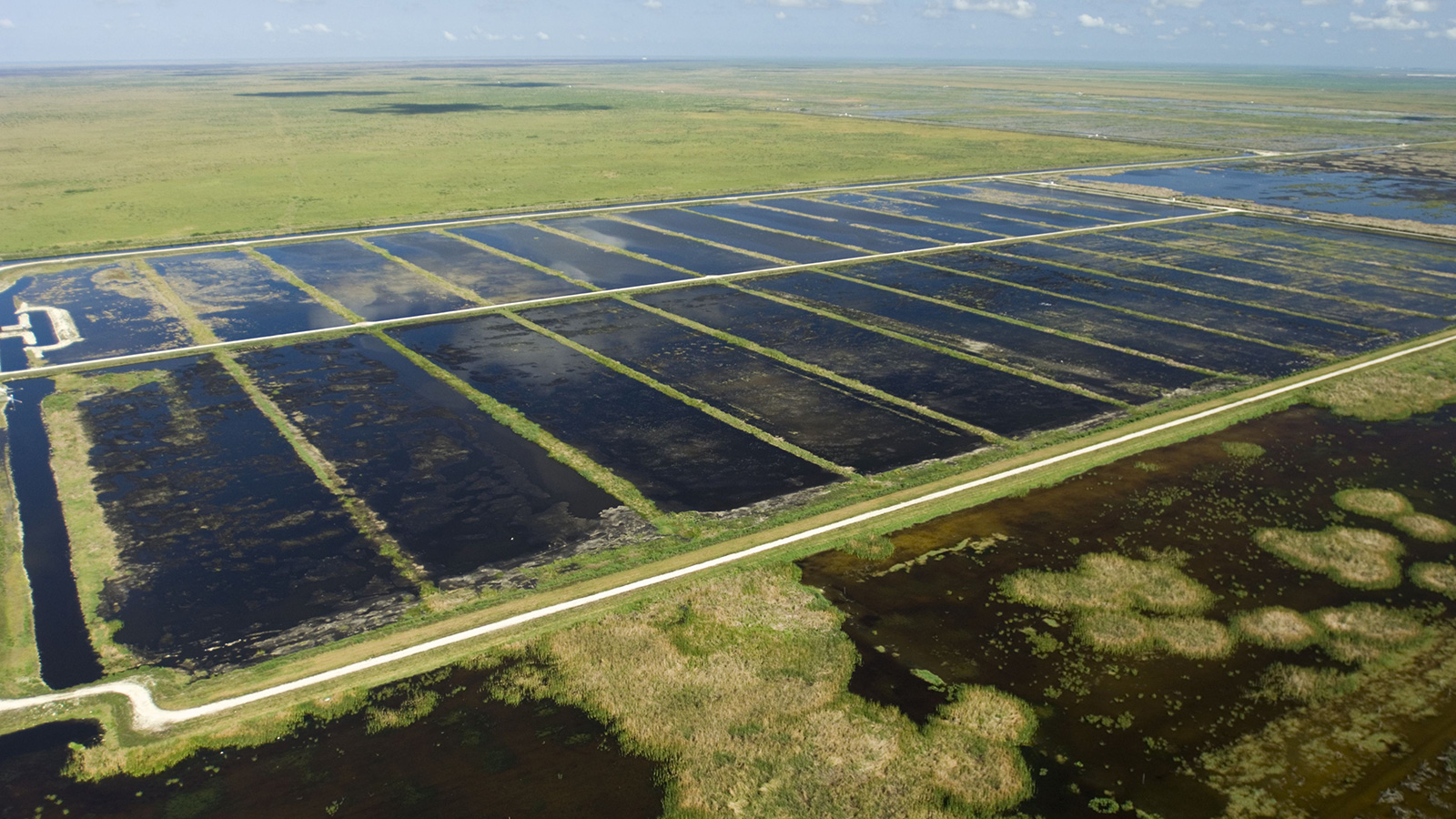
Constructed wetlands near the Everglades. Photo: South Florida Water Management District via USEPA Flickr
Many, if not most, nature-based solutions have potentially significant direct or indirect impacts on ocean health and coastal communities. As an example, oyster bed restoration provides habitat, boosts coastal resilience, improves water quality, and reduces erosion. The primary ocean health benefits that NbS provide are pollution reduction, habitat and biodiversity improvements, greenhouse gas mitigation, coastal adaptation, and climate resilience:
- An estimated 80 percent of marine pollution is land-based,6 and land-based pollution remains a top threat to ocean health.7 Much of that pollution comes from runoff.8 NbS can reduce pollution both on coasts and inland, preventing pollutants from ever reaching the ocean. NbS usually improve water quality, either by controlling peak stormwater flows or providing direct filtration of pollutants. The ability of NbS to filter pollutants has been investigated for many common pollutants of concern, and while research demonstrates that impacts can vary, pollution reduction impacts can be significant for some NbS, including wetlands (constructed and natural),9-12 rain gardens and other filtration solutions,13 permeable pavements,14 and oyster reefs.15-17
- NbS that benefit marine habitat and biodiversity include salt marshes, mangroves, seagrasses, oyster reefs, coral reefs, hybrid reefs, and living shorelines. Protection and restoration of those critical coastal and marine habitats can support biodiversity by providing food, shelter, spawning grounds, and nursery habitat; supporting climate resilience and spatial connectivity to other habitats; and reducing pollution, erosion, and suspended solids.
- NbS can effectively sequester and avoid carbon emissions through natural biological processes and reducing gray infrastructure energy consumption, respectively. The primary GHG mitigation benefits of NbS are the capture and sequestration of carbon, often discussed in the context of blue carbon—the carbon stored in coastal and marine ecosystems such as mangroves, seagrasses, and tidal marshes, which are the most efficient natural carbon sinks on Earth on a per-area basis.18 NbS could contribute an estimated 37 percent of Paris Agreement climate mitigation goals.19 Furthermore, NbS can provide ecosystem services that reduce the need for carbon-intensive measures such as wastewater treatment or the construction of storm barriers.

Excerpted from “Blue Carbon: Integrating Ocean Ecosystems in Global Climate Action”. Download the report from Conservation.org
- NbS such as oyster reefs and living shorelines can provide climate adaptation and resilience benefits to coasts and coastal communities by buffering storm surges, preventing erosion, and reducing wave energy. In general, proponents of NbS note that these solutions can be more resilient and cost effective than gray infrastructure solutions to coastal climate impacts.20-21 NbS also provide more co-benefits and have less environmental impact than gray infrastructure.
What are other benefits of nature-based solutions?
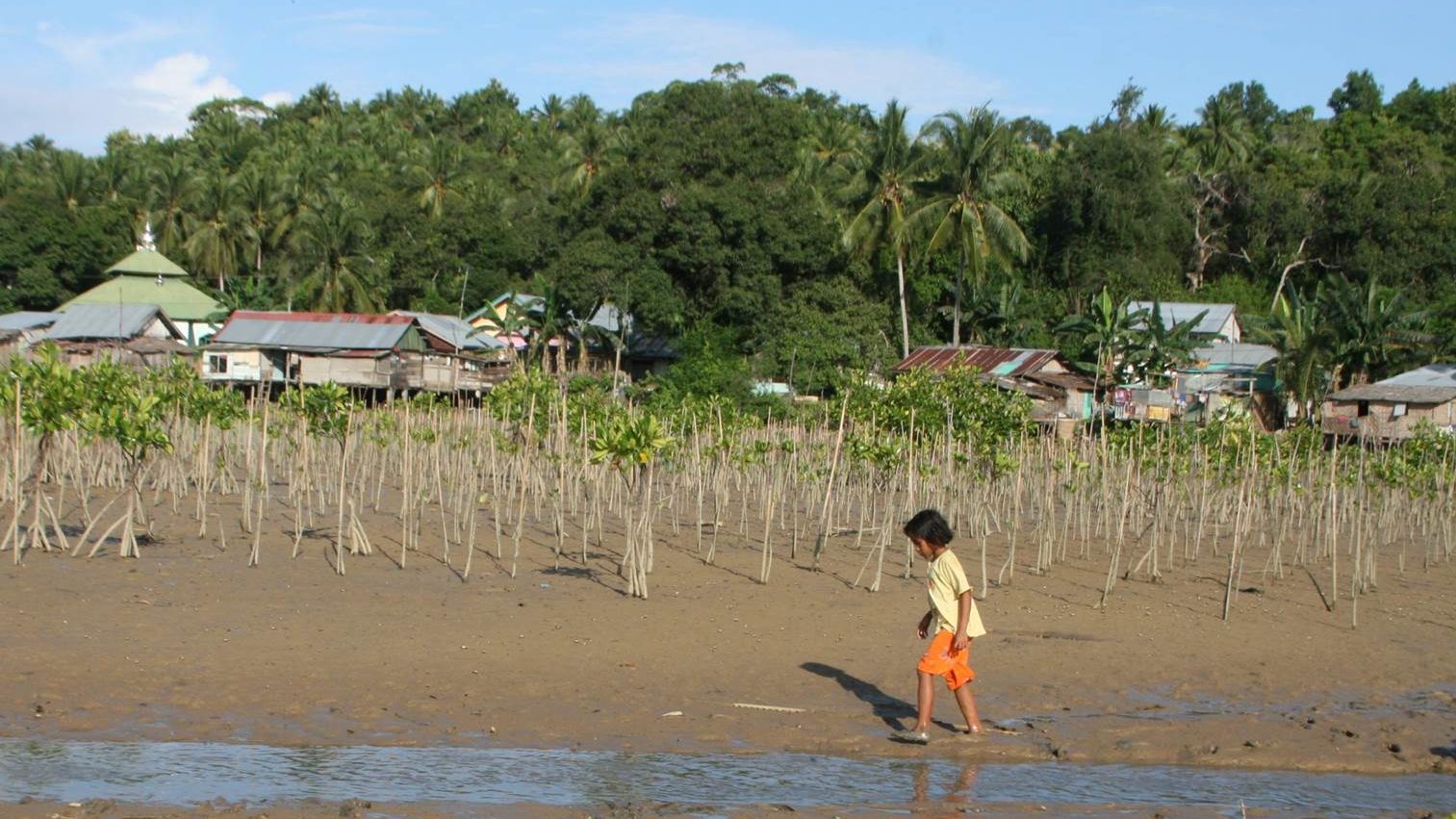
Mangroves replanted in Southwest Sulawesi, Indonesia. Photo: USAID via Flickr
NbS are cost-effective, resilient approaches to environmental challenges that confer multiple environmental and community benefits, particularly compared to gray infrastructure. NbS can provide benefits including flood protection, urban heat reduction, avoidance or reduction of GHGs, habitat and biodiversity benefits, green space and human well-being benefits, and air, soil, and water quality improvements. In terms of human benefits, NbS can improve air and water quality, buffer natural disasters, control flooding, reduce urban heat effects, and increase green space. They can be implemented through participatory processes and newly created green jobs. Importantly, while NbS can be implemented in ways that exacerbate existing inequalities, there are opportunities for NbS to alleviate injustice and be transformative for both the environment and society.
How can funders support nature-based solutions?
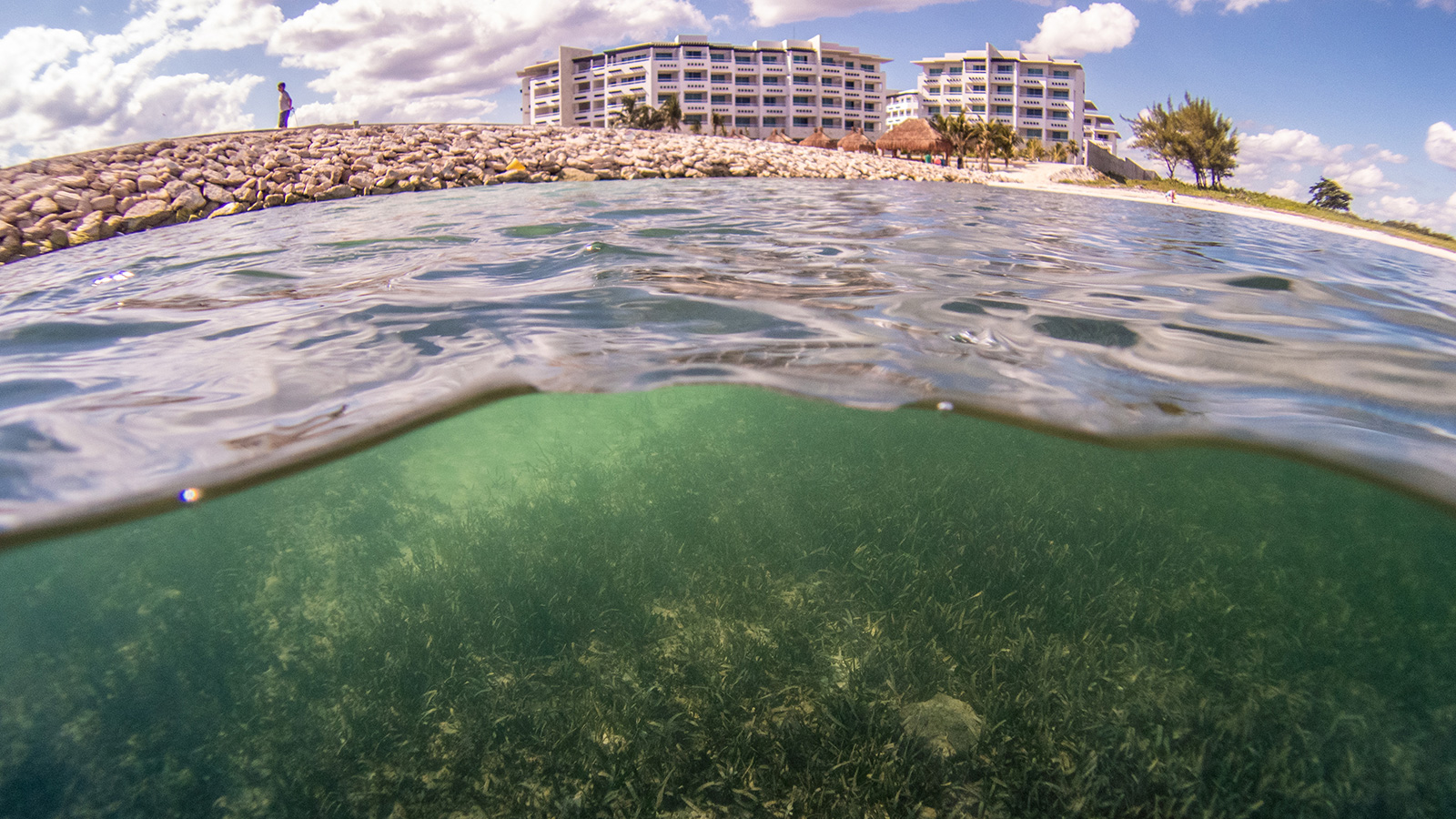
Seagrass and coastal development in Mexico. Photo: Ben Jones / Ocean Image Bank
There are numerous ways that philanthropy and NGOs can support engagement around nature-based solutions at various scales, from local to global. Example entry points include:
- Elevate policymaker awareness around public health and environmental justice benefits of nature-based solutions, which includes improving coastal water quality, increasing green space, and potential job creation (e.g., building constructed wetlands and urban gardens).
- Advocate for public and private investment in stormwater reduction solutions (including through green infrastructure and nature-based solutions) to reduce combined sewer overflows and increase coastal resilience to flooding and pollution events.
- Support scientific research and capacity building to integrate blue carbon in climate mitigation, adaptation, and resilience commitments. This may include educating policymakers and providing resources to governments to assess, monitor, and account for the climate mitigation and adaptation potential of blue carbon ecosystems. More specifically, it may include coordinating with governments to incorporate blue carbon into nationally-determined contributions, national greenhouse gas inventories, and other national climate policies.
- Advocate for inclusive and equitable policy agreements and processes that recognize the rights and participation of Indigenous peoples and local communities in the context of climate action. This may include actively considering and incorporating the knowledge of Indigenous peoples and local communities (IPLC) and supporting efforts for IPLC partners to conserve and restore blue carbon ecosystems through global targets and agreements, such as through the Paris Agreement and Convention on Biological Diversity.
Notes
- EESI, “Nature as Resilient Infrastructure – An Overview of Nature-Based Solutions,” Environmental and Energy Study Institute, October 16, 2019, https://www.eesi.org/papers/view/fact-sheet-nature-as-resilient-infrastructure-an-overview-of-nature-based-solutions.
- IUCN, “Nature-Based Solutions,” accessed April 26, 2021, https://www.iucn.org/commissions/commission-ecosystem-management/our-work/nature-based-solutions.
- EESI, “Nature as Resilient Infrastructure – An Overview of Nature-Based Solutions.”
- US EPA, OW, “What Is Green Infrastructure?” Overviews and Factsheets, September 30, 2015, https://www.epa.gov/green-infrastructure/what-green-infrastructure.
- IUCN, “Nature-Based Solutions.”
- NOAA, “What Is the Biggest Source of Pollution in the Ocean?” accessed June 7, 2021, https://oceanservice.noaa.gov/facts/pollution.html.
- Benjamin S. Halpern et al., “Recent Pace of Change in Human Impact on the World’s Ocean,” Scientific Reports 9, no. 1 (December 2019): 11609, https://doi.org/10.1038/s41598-019-47201-9.
- NOAA, “What Is the Biggest Source of Pollution in the Ocean?”
- Jingqiu Chen et al., “Evaluation of the Effectiveness of Green Infrastructure on Hydrology and Water Quality in a Combined Sewer Overflow Community,” Science of the Total Environment 665 (May 15, 2019): 69–79, https://doi.org/10.1016/j.scitotenv.2019.01.416.
- Qintong Wang et al. “Horizontal Subsurface Flow Constructed Wetlands as Tertiary Treatment: Can They Be an Efficient Barrier for Microplastics Pollution?” Science of The Total Environment 721 (June 15, 2020): 137785, https://doi.org/10.1016/j.scitotenv.2020.137785.
- Hayes A. Lenhart and William F. Hunt, “Evaluating Four Storm-Water Performance Metrics with a North Carolina Coastal Plain Storm-Water Wetland,” Journal of Environmental Engineering 137, no. 2 (February 2011), https://ascelibrary.org/doi/10.1061/%28ASCE%29EE.1943-7870.0000307.
- J.M. Hathaway, W. F. Hunt, and S. Jadlocki, “Indicator Bacteria Removal in Storm-Water Best Management Practices in Charlotte, North Carolina,” Journal of Environmental Engineering 135, no. 12 (December 1, 2009): 1275–85, https://doi.org/10.1061/(ASCE)EE.1943-7870.0000107.
- Alicia Gilbreath et al., “Multiyear Water Quality Performance and Mass Accumulation of PCBs, Mercury, Methylmercury, Copper, and Microplastics in a Bioretention Rain Garden,” Journal of Sustainable Water in the Built Environment 5, no. 4, (November 2019), https://ascelibrary.org/doi/abs/10.1061/JSWBAY.0000883.
- Chi-Feng Chen and Jen-Yang Lin, “Application of the SUSTAIN Model to a Watershed-Scale Case for Water Quality Management,” paper presented at the International Low Impact Development Conference of the American Society of Civil Engineers, Houston, Texas, January 15, 2015, https://doi.org/10.1061/9780784479025.003.
- Lisa M. Kellogg et al., “Denitrification and Nutrient Assimilation on a Restored Oyster Reef,” Marine Ecology Progress Series 480 (April 22, 2013): 1–19, https://doi.org/10.3354/meps10331.
- Jonathan Adams, “Research: Can Restoring Oyster Reefs Combat Nitrogen Pollution?” Cool Green Science (blog), The Nature Conservancy, September 10, 2013, https://blog.nature.org/science/2013/09/10/restoring-oyster-reefs/.
- Hasan Volkan Oral et al., “A Review of Nature-Based Solutions for Urban Water Management in European Circular Cities: A Critical Assessment Based on Case Studies and Literature,” Blue-Green Systems 2, no. 1 (January 3, 2020): 112–36, https://doi.org/10.2166/bgs.2020.932.
- Emily Pidgeon et al., “Blue Carbon Integrating Ocean Ecosystems in Global Climate Action,” October 2021, https://www.conservation.org/docs/default-source/publication-pdfs/blue-carbon-integrating-ocean-ecosystems-october-2021a.pdf?Status=Master&sfvrsn=304117ec_2.
- IUCN, “Nature-Based Solutions.”
- Siddharth Narayan et al., “The Effectiveness, Costs and Coastal Protection Benefits of Natural and Nature-Based Defences,” PloS One 11, no. 5 (2016), e0154735, https://doi.org/10.1371/journal.pone.0154735.
- EESI, “Nature as Resilient Infrastructure – An Overview of Nature-Based Solutions.”

